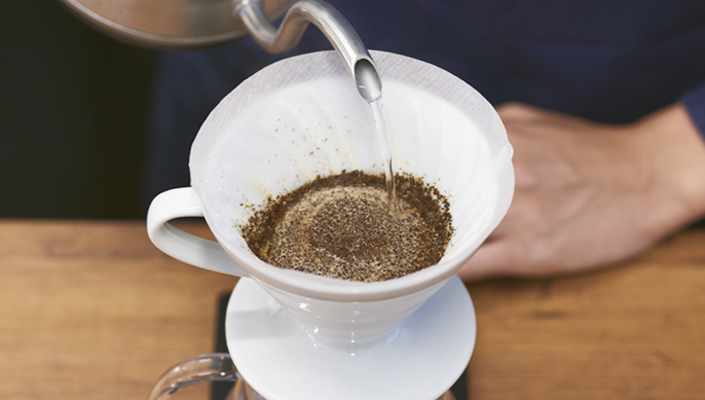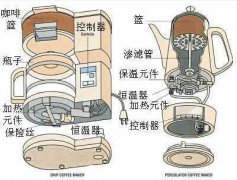The characteristics of the extraction of hand-brewed coffee explain the three factors that change the taste of hand-brewed coffee

Professional coffee knowledge exchange more coffee bean information please follow the coffee workshop (Wechat official account cafe_style)
Seven factors affecting hand-brewed coffee
The extraction process of hand-brewed coffee has two steps.
The first step is to transfer the ingredients on the surface of the coffee powder to water. The rate of transfer of these components is related to their own concentration. If the concentration of the surface component of the coffee powder is high and the concentration of the coffee component in the water is low, the transfer rate of the component is fast. Therefore, at the initial stage of extraction, the rate of transfer of coffee ingredients to the water is fast, and with the change of time, the speed will become slower and slower. The amount of coffee dissolved in water in the first minute of brewing coffee will be much greater than that in a certain minute after a period of time.
The second step is to move the coffee ingredients from the center of the coffee powder to the surface. In the first step, the ingredients on the surface of the coffee powder have been dissolved in water, so the concentration on the surface of the coffee powder decreases, which leads to the second step-the movement of coffee ingredients. The second step moves more slowly than the first step. What we say, "if the raw materials and brewing methods of coffee beans are different, the taste of coffee is also different." in fact, it is the effect of the second step of extraction.
As the ingredients on the surface dissolve, the ingredients move from the center to the surface and dissolve out, the sour taste comes out early, and the bitterness comes out slowly.
The brewing method of coffee is, in a word, even by controlling and balancing the amount of extraction of various ingredients in roasted beans. The total amount of sour and bitter ingredients in coffee is determined by the raw materials, so the choice of raw materials is very important.
With different degrees of extraction, the taste of coffee is also different. During extraction, the following factors affect the taste of coffee: water temperature (water temperature when in contact with coffee powder), time (contact time between water and coffee powder), and the size of coffee powder particles.
1. The temperature of water can change the taste of coffee.
If the water temperature is too high, it will speed up the dissolution of coffee powder ingredients. The sour taste itself dissolves very fast, and no matter how high the water temperature is, the total amount of acid dissolved in the water will not change much. The bitterness dissolves slowly. If the water temperature is high, the bitterness will move faster from the center of the coffee powder to the surface, the total amount of bitterness in the water will increase, and the proportion of bitterness in the coffee will increase. On the other hand, if the water temperature is low, the bitterness in the coffee will be reduced.
two。 Extraction time can change the taste of coffee
The sour taste dissolves quickly, so the amount of acid dissolved into the water in 3 minutes is not much different from that in 5 minutes (by the 3rd minute, the acid is basically dissolved). The bitterness dissolves slowly, so the amount of bitterness dissolved in water in 3 minutes is quite different from that in 5 minutes. In short, if you increase the extraction time, the longer the time, the more bitter the coffee.
3. The size of coffee powder particles can change the taste of coffee.
The finer the coffee powder is ground, the easier it is to get the ingredients out. For sour ingredients that are already easy to dissolve, the size of coffee powder particles has little effect on it. However, for insoluble bitter ingredients, the size of coffee powder particles has an important meaning. Coffee powder particles are small, the total amount of bitterness dissolved in water is very large, and the proportion of bitterness is very large.
.
Important Notice :
前街咖啡 FrontStreet Coffee has moved to new addredd:
FrontStreet Coffee Address: 315,Donghua East Road,GuangZhou
Tel:020 38364473
- Prev

How much water are you still bothering to make 15g or 20g of coffee? Make coffee by hand, make lazybones for five minutes.
Professional coffee knowledge exchange more coffee bean information please pay attention to the coffee workshop (Wechat official account cafe_style) seven factors affecting hand-brewed coffee hand-brewed coffee seems to be a very esoteric art. Well, indeed, the editor has no intention of packaging it as a simple and special thing, because it is really complicated to study, such as the grinding degree of coffee beans, the time of brewing, and water injection.
- Next

The difference between hand-brewed coffee and American coffee maker the difference and common ground between American drip coffee and hand-brewed coffee
Professional coffee knowledge exchange more coffee bean information please pay attention to the coffee workshop (Wechat official account cafe_style) the seven factors that affect hand-brewed coffee have differences and similarities, and let me talk slowly, first talk about your friend's American coffee machine, that is, American-style filter coffee. Bunn successfully developed the first commercial American coffee machine in 1963 and entered in 1967 after improvement.
Related
- Beginners will see the "Coffee pull flower" guide!
- What is the difference between ice blog purified milk and ordinary milk coffee?
- Why is the Philippines the largest producer of crops in Liberia?
- For coffee extraction, should the fine powder be retained?
- How does extracted espresso fill pressed powder? How much strength does it take to press the powder?
- How to make jasmine cold extract coffee? Is the jasmine + latte good?
- Will this little toy really make the coffee taste better? How does Lily Drip affect coffee extraction?
- Will the action of slapping the filter cup also affect coffee extraction?
- What's the difference between powder-to-water ratio and powder-to-liquid ratio?
- What is the Ethiopian local species? What does it have to do with Heirloom native species?

